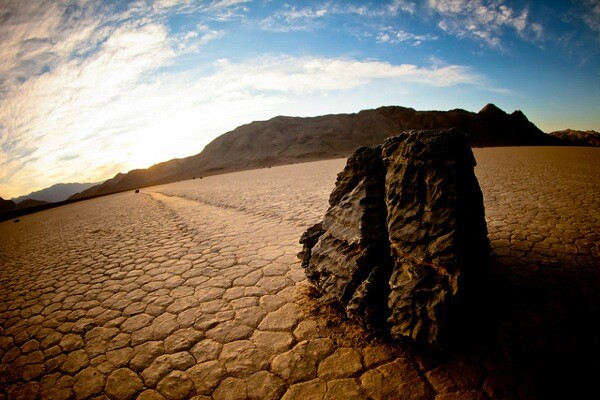'Moving Rocks' Mystery at Death Valley's Racetrack May Be Solved

The mysterious moving rocks of Racetrack Playa in Death Valley National Park have fascinated and perplexed visitors for decades. Scattered across the usually dry lake bed, the stones occupy the ends of furrows, or "trails," that the stones apparently plow in the lakebed as they move, propelled by some mysterious force.
Explanations for this odd desert phenomenon have ranged from strong winds and thick sheets of ice lifting the rocks to an algal mat on the lakebed surface that becomes slippery when wet.
This old mystery may have been solved this week. A research paper published Wednesday in the open-access journal PLOS-One suggests that the rocks may move across the surface of the playa propelled by nothing more than light winds and a little water. And they back it up with the first documented observation of the rocks actually moving.
Beginning in 2011, the research team, led by paleobiologist Richard Norris of the Scripps Institution of Oceanography, UC San Diego, brought new rocks to Racetrack Playa, each with an embedded GPS unit. (The National Park Service declined to let the team drill holes in the existing rocks.) Each GPS unit was set up to turn on if its rock moved away from a magnet embedded in the lakebed. That way, if the imported rocks moved the same way the native ones did, Norris' team would be able to track their movements.
That could have been a long wait: the rocks on Racetrack Playa sometimes stay put for decades. "Science sometimes has an element of luck," said Norris. "We expected to wait five or ten years without anything moving, but only two years into the project, we just happened to be there at the right time to see it happen in person."

That right time was in December 2013. Norris and his cousin and co-author James Norris arrived at Racetrack Playa to find the lake held about three inches of very cold water. At night a film of ice formed on the surface of the water. The next morning, as the sun came up and warmed the ice a bit, it broke up into large, thin sheets. A light wind moved those sheets around. Some of those ice sheets pushed the playa's famous stones in front of them as if the ice was a sail, with the stones plowing a trail in the softened playa mud.
The rocks moved at speeds of a few inches per second, which raises the possibility that though December 2013 marked the first documented observation of the rocks moving, it might not have been the first time someone was there as they moved. At a distance, and with all the rocks moving in the same direction at the same low speed, a casual observer might well watch the rocks carefully without knowing they were moving. "It's possible that tourists have actually seen this happening without realizing it," said Jim Norris. "It is really tough to gauge that a rock is in motion if all the rocks around it are also moving."
Until the Norris's study, the most popular explanation for the rocks' odd trails across the surface of the playa involved fiercely cold weather and gale-force winds. That hypothesis suggested the rocks would become embedded in thick collars of ice that would float them slightly, and that strong winds would drag the rocky ice sheets across the muddy playa floor.
And that might still be true for the playa's largest rocks, which didn't move in the December 2013 event, or in five other mass rock moves the Norrises observed. "We documented five move events in the two and a half months the pond existed and some involved hundreds of rocks", says Richard Norris, "So we have seen that even in Death Valley, famous for its heat, floating ice is a powerful force driving rock motion. But we have not seen the really big boys move out there: does that work the same way?"
Which is even more good news for fans of Racetrack Playa: there remains a bit more mystery to the place.